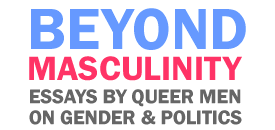

|
|

EXPOSING MASCULINITIES:
My Journey as a Queer Artist
|
 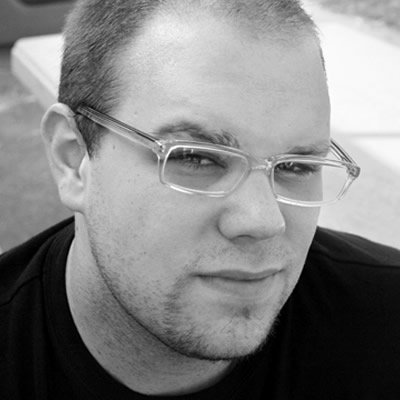
Sean Gyshen Fennell
|
By Sean Gyshen Fennell
Sean Gyshen Fennell is queer artist and activist originally from the Pacific Northwest. He attended Willamette University in Salem, Oregon and recently completed his graduate work at Washington University in St. Louis, Sam Fox School of Design and Visual Arts. Fennell is currently living in Denver, Colorado and teaching at the University of Denver, School of Art. |

|
PREVIEW MP3 RECORDING:
This text will be replaced by the flash music player.
|
|
|

his
essay chronicles my experience as a young queer artist. The narrative of what
follows reflects my creative process; it begins by speaking intellectually about
my reasons for making art and begins to become more personal as the work
develops. I conclude by discussing some of the artists and theorists that have
guided me through this creative process. While my works do not always have a
common aesthetic, they are interconnected, and the linear form of this essay
reveals the connections between the various pieces and the momentum of their
progression.
 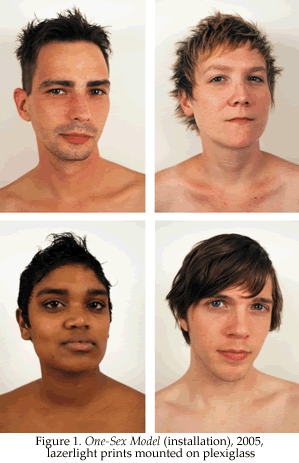 I am fascinated by
the actual nature of gender and investigate how it relates to ideas surrounding
self-representation. This prompted my, “One-Sex Models.” In the project I
attempted to find and photograph people who I felt were, to varying degrees,
existing outside gender norms. I did not want every model to be completely
androgynous but to have an element, through either physical structure, gaze or
pose, of gender ambiguity; I wanted to blur the categories rather than create a
new one. I chose to photograph each individual on a white background with a soft
but revealing light to give a stark, yet glamorous aesthetic to the work in
order to call attention to and explore the personal androgyny of the models. The
title “One-Sex Models” was meant to reference the notion of gender as a
continuum rather than a distinct categorization. I am fascinated by
the actual nature of gender and investigate how it relates to ideas surrounding
self-representation. This prompted my, “One-Sex Models.” In the project I
attempted to find and photograph people who I felt were, to varying degrees,
existing outside gender norms. I did not want every model to be completely
androgynous but to have an element, through either physical structure, gaze or
pose, of gender ambiguity; I wanted to blur the categories rather than create a
new one. I chose to photograph each individual on a white background with a soft
but revealing light to give a stark, yet glamorous aesthetic to the work in
order to call attention to and explore the personal androgyny of the models. The
title “One-Sex Models” was meant to reference the notion of gender as a
continuum rather than a distinct categorization. [1]
I found that by questioning the validity of gender I am also, and perhaps more
effectively, addressing the validity of sexuality.
 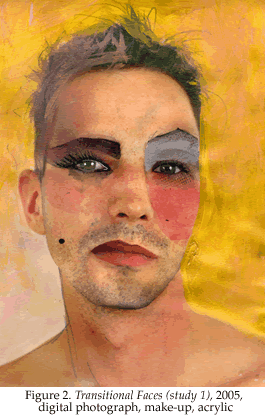 While creating “One-Sex Models” I was also working with some of the same images
in an aesthetically and conceptually different fashion to create
“Transitional-Faces.” This work explores externalized psychological states of
how some queer men explore gender. From firsthand experience and observations in
the queer community such exploration can take many forms ranging from drag to
hyper-masculinity. I chose to investigate the effeminate side of this
exploration, which mimics my own experience. I worked with the most “masculine”
of the images in order to give the images more gender range and conflict. To
achieve this effect I used paint and make-up on the surface of the images to put
the faces into tumultuous states of drag. While creating “One-Sex Models” I was also working with some of the same images
in an aesthetically and conceptually different fashion to create
“Transitional-Faces.” This work explores externalized psychological states of
how some queer men explore gender. From firsthand experience and observations in
the queer community such exploration can take many forms ranging from drag to
hyper-masculinity. I chose to investigate the effeminate side of this
exploration, which mimics my own experience. I worked with the most “masculine”
of the images in order to give the images more gender range and conflict. To
achieve this effect I used paint and make-up on the surface of the images to put
the faces into tumultuous states of drag.
Though aesthetically disparate both “One-Sex Models” and “Transitional Faces”
were created during the same time and used the same models. These works revealed
an interesting dynamic in my art: the psychological state creating
self-representation. This realization would not surface again until “Sewing the
Façade” and “Veiled,” which will be discussed further in the paper.
 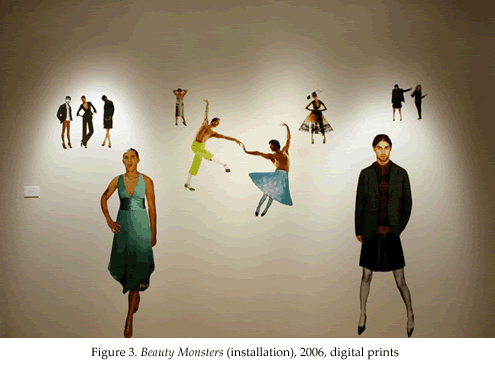 After the previous projects I began to investigate the various sources that may
inform ideas of self-representation to create “Beauty Monsters.” I became
particularly interested in the sources that directly depicted the notions of
hyper-beauty and body: fashion, fitness and porn magazines. I began obsessively
consuming and cutting up these magazines and would then spend hours piecing
together various disembodied parts to create grotesque figures out of idealized
gendered forms. I took great care when constructing these images to make them as
visually seamless as possible to heighten the work’s plausibility. These figures
were then scanned and printed in various scales from life-size to the
approximate size they would have originally been in a magazine. In the final
presentation, they were pasted to a gallery wall to appear as if an army of
Beauty Monsters was about to march into the space of the viewer. Among my
constructed figures I included one image that was directly scanned from the
magazine. The inclusion of this figure both highlighted the ridiculousness of
fashion images and made my constructions more believable. The intent of “Beauty
Monsters,” beyond an investigation of these sources, is to again provide visual
depictions of a queer gender continuum. In this way “Beauty Monsters” is
conceptually similar to “One-Sex Models.” After the previous projects I began to investigate the various sources that may
inform ideas of self-representation to create “Beauty Monsters.” I became
particularly interested in the sources that directly depicted the notions of
hyper-beauty and body: fashion, fitness and porn magazines. I began obsessively
consuming and cutting up these magazines and would then spend hours piecing
together various disembodied parts to create grotesque figures out of idealized
gendered forms. I took great care when constructing these images to make them as
visually seamless as possible to heighten the work’s plausibility. These figures
were then scanned and printed in various scales from life-size to the
approximate size they would have originally been in a magazine. In the final
presentation, they were pasted to a gallery wall to appear as if an army of
Beauty Monsters was about to march into the space of the viewer. Among my
constructed figures I included one image that was directly scanned from the
magazine. The inclusion of this figure both highlighted the ridiculousness of
fashion images and made my constructions more believable. The intent of “Beauty
Monsters,” beyond an investigation of these sources, is to again provide visual
depictions of a queer gender continuum. In this way “Beauty Monsters” is
conceptually similar to “One-Sex Models.”
 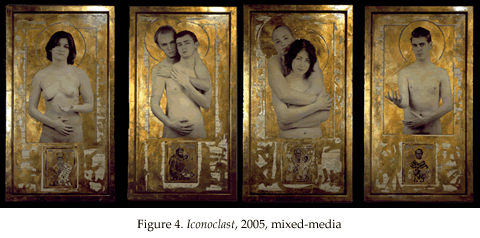 While working with ideas surrounding gender, a series I had created previously,
titled “Iconoclast” began to receive some controversial press. While working with ideas surrounding gender, a series I had created previously,
titled “Iconoclast” began to receive some controversial press. [2]
This was the result of some conservative activists objecting to my work being
publicly placed at my undergraduate university. This caused them to photograph my
work and appeal to several conservative media personalities. Lars Larson, a
conservative radio talk show host, picked up the story. I was notified by some
of my friends in Oregon and subsequently called The Lars Larson Show and
was interviewed (see Appendix 1, "Interview Transcript").
After this I made my own appeal to the liberal press and was published in The
Advocate and picked-up by other small Oregon-based newspapers. Through being
in The Advocate, I was contacted by members of the Catholic gay
community. This was around the time that Pope John Paul II died and Pope
Benedict XVI was appointed. His appointment is the source of turmoil amongst gay
Catholics, especially after the Church issued a new document on the church’s
view on homosexuality. I could not resist making a documentary about being queer
and Catholic in this turbulent time in the Catholic Church. While this seemed a
departure from the work I was engaged in I felt compelled to make the
documentary “A Place at the Table.”
 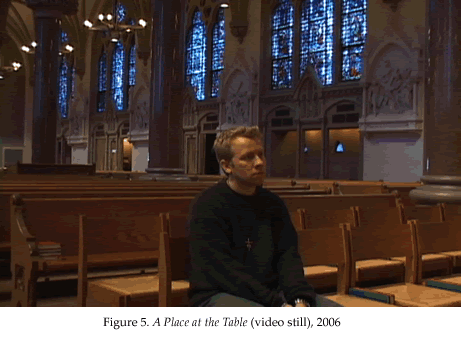 Despite my connections I began to face a great deal of resistance from both the
straight and gay Catholic community. The gay community was afraid they would
face discrimination if they were part of the documentary and the straight
community did not want the issue talked about. Fortunately, I had become friends
with Brother Brian Halderman, a ‘religious’ in The Society of Mary (a sect of
the Roman Catholic Church), who was one of the first openly gay people to enter
religious life in the Catholic Church. He became the largest supporter of “A
Place at the Table.” He put me in contact with many other gay Catholics, over
fifty people in all, of which only seven allowed me to interview them. To gain
more familiarity I began to be an active member of the gay Catholic community. I
volunteered at Catholic booths at queer events, sang in the Catholic choir for
the Sounds of Acceptance benefit, and attended Peace and Justice meetings (a gay
friendly Catholic organization). By doing these activities I not only was able
to meet more gay Catholics but gained firsthand knowledge of the discrimination
gay Catholics have to endure, both from the queer community and within the
Church. This helped me gain the proper perspective for the work... (continue reading) Despite my connections I began to face a great deal of resistance from both the
straight and gay Catholic community. The gay community was afraid they would
face discrimination if they were part of the documentary and the straight
community did not want the issue talked about. Fortunately, I had become friends
with Brother Brian Halderman, a ‘religious’ in The Society of Mary (a sect of
the Roman Catholic Church), who was one of the first openly gay people to enter
religious life in the Catholic Church. He became the largest supporter of “A
Place at the Table.” He put me in contact with many other gay Catholics, over
fifty people in all, of which only seven allowed me to interview them. To gain
more familiarity I began to be an active member of the gay Catholic community. I
volunteered at Catholic booths at queer events, sang in the Catholic choir for
the Sounds of Acceptance benefit, and attended Peace and Justice meetings (a gay
friendly Catholic organization). By doing these activities I not only was able
to meet more gay Catholics but gained firsthand knowledge of the discrimination
gay Catholics have to endure, both from the queer community and within the
Church. This helped me gain the proper perspective for the work... (continue reading) |
|
Navigate:
1 | 2 | 3 | 4 | 5 | 6 | Next Page >>
|
|




3 COMMENTS ON THIS ESSAY:
I love your art, especially the iconoclast images. Can I find them online elsewhere?
This type of art also highlights the similarities between devotion to religion and devotion to your partner, which I think is closer than a lot of people think.
simply stunning...:)
We are running a short feature of your art on www.redlimemagazine.com until Feb 4th
Your work is beautiful!